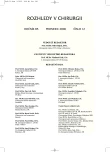Anterior Skull Base Reconstruction
Authors:
G. Hanoun; Marek Sova; M. Smrčka; V. Smrčka
Authors‘ workplace:
Neurochirurgická klinika FN Brno-Bohunice
Published in:
Rozhl. Chir., 2006, roč. 85, č. 12, s. 593-598.
Category:
Monothematic special - Original
Overview
The reasons for transcranial operative revision of anterior cranial fossa are cerebrospinal fluid (CSF) leakage, pneumocephalus, recurrent meningitis and eventually other causes. The trauma is the most common etiology of previously mentioned pathologic statuses, rarely it can also be long-lasting intracranial hypertension.
We retrospectively analyzed our 61 patients, operatively treated at Department of Neurosurgery in Brno-Bohunice between 1997 and 2005, at whom the cranionasal communication must have been treated by means of transcranial neurosurgical repair of anterior fossa skull base. Each year approximately 10–15 operations of this kind were performed. The main goal of operative solution was the water-tight closure of dural defect and cranial base by means of direct dural suture duroplasty with periostal flap, fascial flap or other graft. Each case solution was dependent on actual operative appearance of the operative field. The majority of transcranial repairs of frontal cerebral fossas were performed acutely as a part of frontobasal injury operation with haematoma, calvar impressive fractures and open cerebral injury. The minority of repairs is formed by elective operations for posttraumatic rhinnorhea and meningitis. In our announcement we also mention possible conservative treatment.
Key words:
liquorhea – cranionasal communication – skull base
Labels
Surgery Orthopaedics Trauma surgeryArticle was published in
Perspectives in Surgery

2006 Issue 12
Most read in this issue
- Consequennce of Nontreatment Scapholunate Instability of the Wrist
- Anterior Skull Base Reconstruction
- Autovenous Ilicofemoral Bypass, 21 Years Later – A Case-Review
- Gastric Carcinoid – A Case Review
